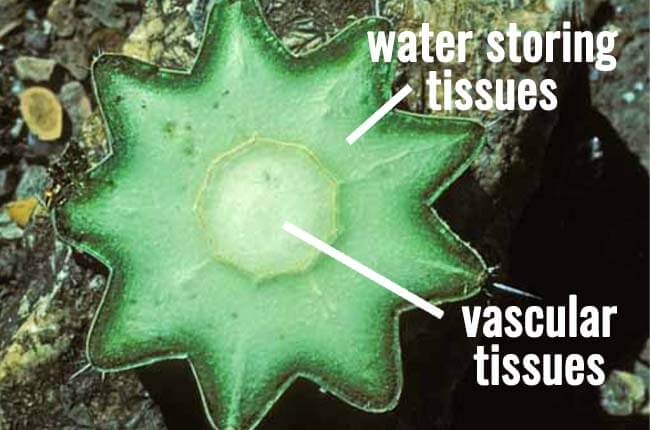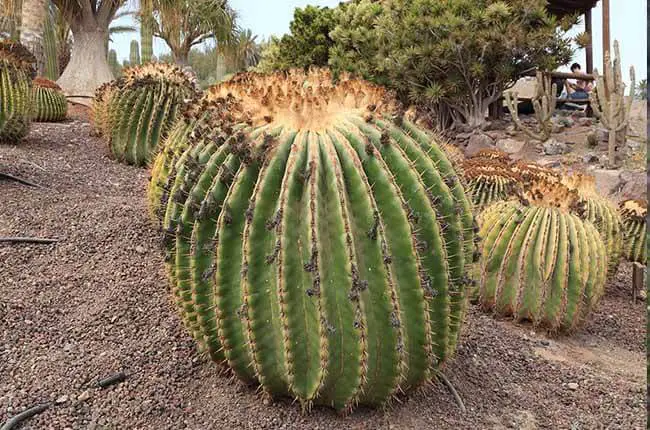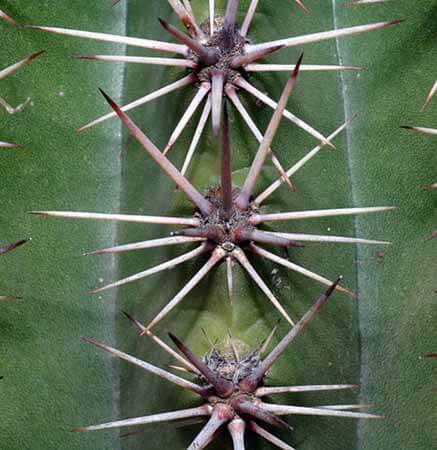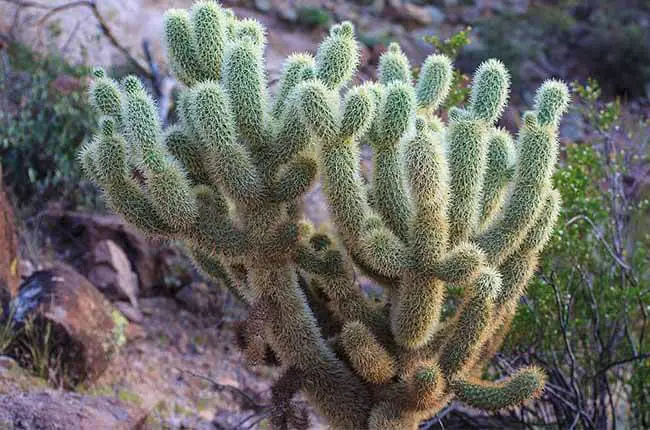Don’t be fooled by the small size of a cactus. One that is sized like a ping pong ball can be 3 years old, and one that resembles a football can easily be over 20 years old.
So, how do we determine the age of a cactus?
There is no certain way to determine the age of a cactus because their stems do not have annual rings like most wooden trees. Their age can only be estimated based on the height/size relative to the species, the number of areoles, and their growing conditions.
Let’s take a deeper look.
Cactus stems do not have growth rings
The reason why it is difficult to accurately determine the age of cacti is that, unlike most trees, the stems of cacti do not have growth rings, which are basically lignified vascular tissues (xylem and phloem) that increment each year.
The cactus stems are composed of mainly water-storing tissues surrounding bundles of vascular tissues in the center.
Their inability to make growth rings is believed to be related to their unusually dry living environment.

Trees in temperate and sub-tropical latitudes, on the other hand, have visible growth rings because of the change in growth speed due to rainy and dry seasons and high and low temperatures in spring and winter.
The longer nights after the summer solstice are the primary signal for trees to reduce resources from height growth to growing the trunk. Trees grow more during wetter seasons and at their preferred temperature, and they grow less during stressful periods such as drought and at lower temperatures.
A contrast in cell wall thickness results in visible growth rings.
How to determine the age of a cactus
1. Height or size of the cactus species
There are over 300 genera and 3000 species of cacti discovered, and each type has its own speed of growth.
We would need to observe the species for a few years to know how much growth it puts out per year.
For example, the columnar type, such as the saguaro cactus gains more height than the barrel type. A Golden Barrel cactus (Echinocactus platyacanthus) that is over 100 years old can grow up to 8.2 feet (2.5 meters) tall and 5 feet (1.5 meters) wide.

A Saguaro cactus (Carnegiea gigiantea) with a similar age (around 100 years old) can be 15-16 feet (4.6 meters) tall. According to the National Park Service, the oldest Saguaro cactus ever measured is over 78 feet (24 meters) into the air.
Depending on the height and the growing conditions, the cactus can gain between up to 8 inches (20cm) per year (Drezner, 2003).
| Height of Saguaro cactus | Age |
| 6.5 feet | 70 years old |
| 15-16 feet | 95-100 years old |
| 78 feet | 158 years old |
Unfortunately, there has not been much research about the age-size relationship of other cactus species. Most of the research focuses on Saguaro cactus probably because it is under protection by Arizona State and the Saguaro flower is the state flower. The species has also received much attention because it is one of the oldest and biggest discovered on earth.
2. Precipitation received
Apart from the species, another determining factor of the cactus size is related to the precipitation they receive in their habitat.
Pachycereus pringlei for example grows extremely slowly as it inhabits the western coast of Sonora and the drier parts of the Sonoran Desert, such as Baja California, with no more than 3 inches of rain per year.
In contrast, cacti from environments with more moisture, such as Opuntias or prickly pears from non-desert locations in South America, grow quickly and can outgrow their space.
3. Number of areoles
The number of areoles (singular: areola) is also an indication of the age of the cactus.
An areola is where a cluster of thorns (modified leaves for cactus), flowers, and even a new branch or “arm” may grow.
Young thorns that are less than a year old are usually reddish in color. They grow column by column that those at the top are younger than those at the bottom.

4. Number of arms
Counting the number of arms can also give insights into the age of the cactus.
However, this factor only works for the columnar type of cacti because only the columnar type of cactus grows arms branching off the main stem.
The best example of columnar cacti is the saguaro, which begins to grow arms when it is at least 70 years old. A saguaro with one fully grown arm is at least 100 years old. If there are several arms and flowers, it is probably over 150 years old.
Other globular types of cacti, such as the Golden Barrel cacti, however, do not grow arms.
5. Species
When trying to determine the age of your cactus, also consider the species because different species have different growing speeds.
In general, the smaller cacti, especially those that are typically grown as houseplants, can grow much more quickly. For instance, Echinopsis species, also known as hedgehog cacti, can grow several inches in a year under the right conditions. Other cacti, like the barrell cactus, also tend to grow more quickly.
The saguaro cactus (Carnegiea gigantea) is considered one of the slowest-growing cactus species due to its incredibly slow growth rate, especially during its early years. It may only grow 1 to 1.5 inches in height. After about 15 years, the saguaro may be approximately 6 inches tall. It can take around 50–70 years for the cactus to start growing its first arm.
Another notably slow-growing cactus is the pincushion cactus (Mammillaria). This cactus often grows less than an inch per year. It can take many years for a pincushion cactus to reach its full size, which is typically no more than 6 inches in height.
Astrophytum asterias, also known as the star cactus or sand dollar cactus, is another slow grower. These small cacti, which only reach about an inch in height, can take several years to reach maturity from seed.
Lastly, the Bishop’s Cap Cactus (Astrophytum myriostigma) is another slow-growing cactus, often growing less than an inch per year.
How big can a cactus get?
Age is only one of the determining factors of how big a cactus can grow. Other factors include the type of cactus, temperature, and sunlight.
Most of the small, round ones sold in the store will never become larger than a fist. Others may develop into a clump of several small columns, maybe half a foot in length.
As to temperature and sunlight, some will not grow at all if the mean temperature is below 77 degrees Fahrenheit (25 degrees Celcius).
But generally, some cactus species can live for 200–300 years in the wild before they die from natural hazards.
Conclusion
To sum up, the age of a cactus can only be estimated by understanding the growing speed of the species, the precipitation received, the number of areoles, and, if any, branches on the cactus.
Happy gardening!
Related
Do All Cactus Grow Arms: 3 Factors (Explained)
Top 14 Variegated Cacti (With Pictures)
13 Cacti By Flower Color (With Pictures)
14 Fragrant Succulents & Cacti (You Will Love)
Sources
Saguaro cactus. National Park Service.
Drezner, T.D. (2003). Saguaro (Carnegiea gigantea, Cactaceae) age–height relationships and growth: the development of a general growth curve. Botany, 90 (6), 911-941.
Photo credits
Murray Foubister, CC BY-SA 2.0, via Wikimedia Commons
André Karwath aka Aka, CC BY-SA 2.5, via Wikimedia Commons
Frank Vincentz, CC BY-SA 3.0, via Wikimedia Commons
- Keiki Paste vs Rooting Hormone:What’s the difference? - February 4, 2024
- Top 10 Orchid Fertilizers: A Comprehensive Review (2024) - February 2, 2024
- Top 8 Soil Inoculants For Stronger Plants (2024) - February 1, 2024


